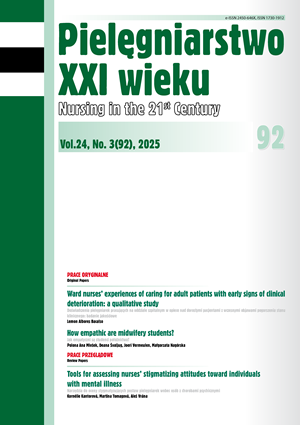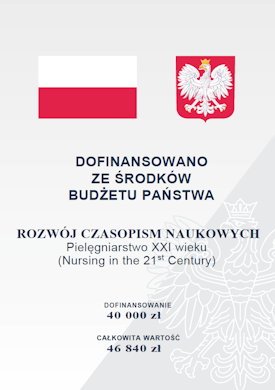Quality of life of patients with diabeticretinopathy receiving anti-VEGF therapy
DOI:
https://doi.org/10.12923/pielxxiw-2025-0025Keywords:
quality of life, diabetic retinopathy, intravitreal injection, state of healthAbstract
QUALITY OF LIFE OF PATIENTS WITH DIABETIC RETINOPATHY RECEIVING ANTI-VEGF THERAPY
Aim. The aim of the study is to analyse opinions of patients with diabetic retinopathy on the impact of anti-VEGF therapy on their quality of life and general health.
Material and methods. The research was conducted between April and July 2023. The study group consisted of 100 people with diabetic retinopathy who were undergoing treatment with VEGF inhibitors. A self-designed survey and the EQ-5D-5L VAS questionnaire were used as research tools.
Results. In the majority of respondents, the duration of diabetes was estimated to be more than 5 years (87%), while DMO was diagnosed 1-5 years ago (63%). Respondents had received an average of 8±6 intravitreal injections of anti-VEGF. The respondents
reported an improvement in quality of life in all EQ-5D-5L VAS dimensions after treatment. Especially, it was an increase in the percentage of respondents who had no problems increased in the dimension of performing usual activities (from 24% to 61%), and in the anxiety/depression dimension (from 16% to 61%). After the treatment, the indexes of quality of life and health status improved regardless of gender, age, place of residence, education, marital status or employment status.
Conclusions. Anti-VEGF therapy has a signifi cant impact on better self-assessment of the health status of people with diabetic retinopathy and improvement of their quality of life.
References
1. Międzynarodowa Federacja Diabetologiczna (IDF). Diabetes Atlas. Edycja 10. https://diabetesatlas.org/ (dostęp: 03.02.2025).
2. Mackiewicz J, Wrona K. Retinopatia cukrzycowa a nowoczesne metody leczenia. Okul. Dypl. 2023;1:19-25.
3. Jurowski P. Retinopatia cukrzycowa i inne choroby oczu w cukrzycy. Po Dyplomie. https://podyplomie.pl/wiedza/wielka-interna/243,retinopatia-cukrzycowa-iinne-choroby-oczu-w-cukrzycy/ (dostęp: 26.09.2023).
4. Gawęcki M. Retinopatia cukrzycowa. Praktyczny podręcznik dla okulistow, diabetologow i internistow. Gdańsk: KMG Dragon’s House, 2021.
5. Teo ZL, Tham Y-Ch, Yu M, et al. Global prevalence of diabetic retinopathy and projection of burden through 2045. Systematic review and meta-analysis. Ophthalmol. 2021;128(11):1580-1591. https://doi.org/10.1016/j.ophtha.2021.04.027
6. Seweryn M, Leszczynska A, Teper S. Potential in the treatment of neovascular Age-related Macular Degeneration and Diabetic Macular Edema in Poland. The population needs and access to therapy. J. Health Policy Outcomes Res. 2024;2:4-12. https://doi.org/10.7365/JHPOR.2024.2.1
7. Witkowska K, Kupcewicz E. Wpływ wybranych czynnikow socjodemografi cznych na jakość życia chorych z cukrzycą typu 2. Przedsiębiorcz. Zarządz. 2014;15(12):189-202.
8. Cooper OAE, Taylor DJ, Crabb DP, et al. Psychological, social and everyday visual impact of diabetic macular oedema and diabetic retinopathy: a systematic review. Diabetic. Med. 2020;37(6):924-933. https://doi.org/10.1111/dme.14125
9. Finger RP, Puth MT, Schmid M, et al. Lifetime outcomes of anti-vascular endothelial growth factor treatment for neovascular age-related macular degeneration. JAMA Ophthalmol. 2020;138(12):1234-1240. https://doi.org/10.1001/jamaophthalmol.2020.3989
10. Finger RP, Daien V, Eldem BM, et al. Anti-vascular endothelial growth factor in neovascular age-related macular degeneration – a systematic review of the impact of anti-VEGF on patient outcomes and healthcare systems. BMC Ophthalmol. 2020;20:294. https://doi.org/10.1186/s12886-020-01554-2
11. Rennen M, Janssen B, Stolk E, et al. EuroQol Research Foundation. EQ-5D-5L User Guide, 2019. https://euroqol.org/publications/user-guides (dostęp: 12.12.2022).
12. Golicki D, Niewada M. EQ-5D-5L Polish population norms. Arch. Med. Sci. 2017;13;1:191-200. https://doi.org/10.5114/aoms.2015.52126
13. Assi L, Chamseddine F, Ibrahim P, et al. A global assessment of eye health and quality of life: a systematic review of systematic reviews. JAMA Ophthalmol. 2021;139:526-541. https://doi.org/10.1001/jamaophthalmol.2021.0146
14. Sajeev PG, Krishnagopal S, Subramanian K. The association between diabetic retinopathy, cognitive impairment, and quality of life - a cross sectional study. Diab. Epidemiol. Manag. 2023;11:100142. http://dx.doi.org/10.1016/j.deman.2023.100142
15. Teper S, Kubicka-Trząska A, Matysik-Woźniak A, et al. Rola doszklistkowych steroidow we wspołczesnym leczeniu cukrzycowego obrzęku plamki. Ophthalmol. J. 2018;3(2):37-46. https://doi.org/10.5603/OJ.2018.0036
16. Lin KY, Hsih WH, Lin YB, et al. Update in the epidemiology, risk factors, screening, and treatment of diabetic retinopathy. J. Diabetes. Investig. 2021;12(8):1322-1325. https://doi.org/10.1111/jdi.13480
17. Sorour OA, Levine ES, Baumal CR, et al. Persistent diabetic macular edema: defi nition, incidence, biomarkers, and treatment methods. Surv. Ophthalmol. 2023;68(2):147-174. https://doi.org/10.1016/j.survophthal.2022.11.008
18. Gross JG, Glassman AR, et al. Writing Committee for the diabetic retinopathy clinical research network, panretinal photocoagulation vs intravitreous ranibizumab for proliferative diabetic retinopathy. JAMA. 2015;314: 2137-2146. https://doi.org/10.1001/jama.2015.15217
19. Saitakis G, Roukas D, Hatziagelaki E, et al. Evaluation of quality of life and emotional disturbances in patients with diabetic retinopathy. Eur. J. Investig. Health Psychol. Educ. 2023;13(11):2516-2528. https://doi.org/10.3390/ejihpe13110175.
Downloads
Published
Issue
Section
License
Copyright (c) 2025 Beata Babiarczyk, Agnieszka Haratyk, Beata Guzak (Autor)

This work is licensed under a Creative Commons Attribution 4.0 International License.




